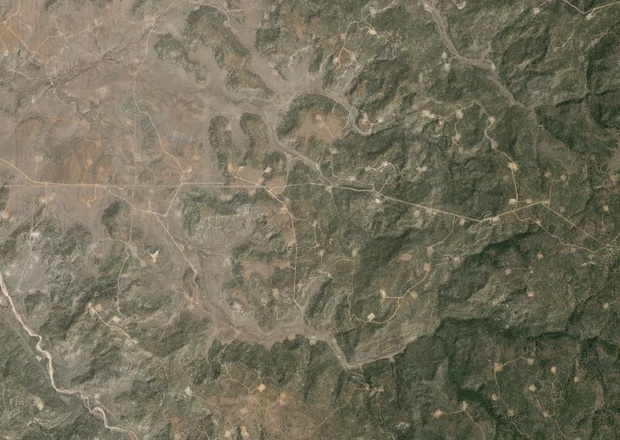Welcome to DU!
The truly grassroots left-of-center political community where regular people, not algorithms, drive the discussions and set the standards.
Join the community:
Create a free account
Support DU (and get rid of ads!):
Become a Star Member
Latest Breaking News
General Discussion
The DU Lounge
All Forums
Issue Forums
Culture Forums
Alliance Forums
Region Forums
Support Forums
Help & Search
Environment & Energy
Related: About this forumScientists Think They Know What's Causing a Big Cloud of Methane Over the Southwest
http://www.citylab.com/weather/2014/10/whats-with-this-cloud-of-methane-over-the-southwest/381324/Methane is an extremely baleful greenhouse gas, with more than 20 times the pound-for-pound impact on global warming as CO2. So imagine the alarm scientists felt when they noticed a big ol' cloud of it, pouring out of the Southwest like noxious vapors from a volcano.
The plume measured half the size of Connecticut and represented the annual release of about 0.59 million metric tons of methane. You can see it floating above the Four Corners region in the above image, which shows how much emissions varied from average background concentrations from 2003 to 2009. While areas with less methane are shown in darker colors, the plume's intense reds and oranges indicate the discharge of more than three times the amount of gas than what had been recorded on the ground.
Scientists initially couldn't believe so much methane was rushing out of the dirt. "We didn't focus on it because we weren't sure if it was a true signal or an instrument error," says NASA's Christian Frankenberg, who first picked up on the gaseous aberration in European satellite data. But experts from the Department of Energy and the University of Michigan verified the widespread leaking, and the guessing game began on where it was coming from.
It couldn't be fracking, because fracking wasn't widespread in the region during the cloud's early years, says Michigan's Eric Kort, who just published a paper titled "The Largest U.S. Methane Anomaly Viewed from Space." Instead, he believes the gas is seeping from the San Juan Basin in northwest New Mexico, which NASA calls the "most active coalbed methane production area in the country." Here is a zoom of the Basin riddled with what looks like industrial outposts:

The huge leaks might've gone unnoticed if it hadn't been for these space-based measurements. (Similar techniques are being used to monitor emissions in Los Angeles.) Here's Kort again:
~~
~~
"The results are indicative that emissions from established fossil fuel harvesting techniques are greater than inventoried," Kort said. "There's been so much attention on high-volume hydraulic fracturing, but we need to consider the industry as a whole."
It seems like this is a situation that deserves more of a sense of urgency. This is a helluva lotof methane flowing into the atmosphere.
Why is there a huge methane hotspot in the American Southwest?
http://www.pbs.org/newshour/updates/huge-methane-hotspot-american-southwest/

The Four Corners region of the southwest United States is a magnificent, otherworldly place, marked by red rock vistas, ancient cliff dwellings and sweeping blue sky. The names alone paint a picture of the landscape: The Painted Desert. The Petrified Forest. Monument Valley.

This image shows methane hotspot, highlighted in red, in the Four Corners area. This map shows how much methane emissions varied from average background concentrations from 2003-2009 (dark colors are lower than average; lighter colors are higher. (AP Photo/NASA, JPL-Caltech, University of Michigan)
But billowing above the rust-colored earth is the country’s largest concentration of methane, according to satellite data. That’s because this spot where Utah, Colorado, Arizona and New Mexico meet is also home to one of the nation’s most productive natural gas fields and coalbed methane basins. About 10 percent of the country’s estimated methane emissions from natural gas is found in this region, according to recent scientific research and the Environmental Protection Agency.
Methane is odorless, colorless and invisible to the naked eye. Following carbon dioxide, methane ranks as the second most prevalent greenhouse gas emitted by human activity in the United States. But in the short term, atmospheric methane is more than 100 times more potent than carbon dioxide at holding the sun’s heat, according to Colm Sweeney, the lead scientist for the NOAA Earth System Research Lab Aircraft Program.
“It’s a very strong greenhouse gas and traps heat really effectively,” he said. “It’s like putting an inch of insulation in your attic versus putting 100 inches of insulation in your attic with the same amount of CO2.”
(more)
InfoView thread info, including edit history
TrashPut this thread in your Trash Can (My DU » Trash Can)
BookmarkAdd this thread to your Bookmarks (My DU » Bookmarks)
3 replies, 1277 views
ShareGet links to this post and/or share on social media
AlertAlert this post for a rule violation
PowersThere are no powers you can use on this post
EditCannot edit other people's posts
ReplyReply to this post
EditCannot edit other people's posts
Rec (15)
ReplyReply to this post
3 replies
 = new reply since forum marked as read
Highlight:
NoneDon't highlight anything
5 newestHighlight 5 most recent replies
= new reply since forum marked as read
Highlight:
NoneDon't highlight anything
5 newestHighlight 5 most recent replies
Scientists Think They Know What's Causing a Big Cloud of Methane Over the Southwest (Original Post)
Bill USA
Jan 2016
OP
underpants
(182,803 posts)1. I thought it was a chili cook off
silverweb
(16,402 posts)2. The fossil fuel industry must die.
[font color="navy" face="Verdana"]The sooner the better.
dixiegrrrrl
(60,010 posts)3. Interesting that this has suddenly been an identified issue
First the Cal. methane leak, which is also visible on the map, and now this one.
so what does the rest of the globe look like, I wonder?